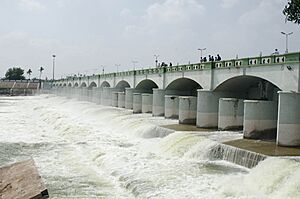Kallanai Dam facts for kids
Quick facts for kids Kallanai Dam |
|
|---|---|

Kallanai Dam with its floodgates open
|
|
| Location | Thanjavur district, Tamil Nadu, India |
| Purpose | Irrigation |
| Status | Operational |
| Construction began | c.150 CE |
| Operator(s) | Government of Tamil Nadu |
| Dam and spillways | |
| Type of dam | Barrage |
| Impounds | River |
| Height (foundation) | 5.4 metres (18 ft) |
| Length | 329 metres (1,079 ft) |
| Width (base) | 20 metres (66 ft) |
The Kallanai Dam, also known as the Grand Anicut, is a very old dam in India. It was built by King Karikala from the Chola dynasty around 150 CE. That's almost 2,000 years ago!
This amazing dam was built across the Kaveri river. The Kaveri river flows through Tamil Nadu, a state in southern India. The dam is located in Thanjavur district. It's about 15 kilometers (9 miles) from Tiruchirapalli city.
The Kallanai Dam is one of the oldest water control structures in the world. It's the oldest one in India that is still used today! People visit it because of its incredible design.
History of the Kallanai Dam
The Kallanai Dam was first built by King Karikalan of the Chola Dynasty. This happened between 100 and 150 CE. The dam is located near Tiruchirappalli city. It's also about 45 kilometers (28 miles) from Thanjavur city.
The main reason for building the dam was to send river water to the delta areas. This helped farmers grow more crops. It made the land very fertile.
Later, the British government improved the dam in the 1800s. In 1804, a military engineer named Captain Caldwell studied the Kaveri river. He wanted to find ways to improve farming in the delta.
Caldwell noticed that a lot of water flowed into another river called the Kollidam. Not enough water was left for farming. He suggested making the dam taller. So, they raised the dam stones by 69 centimeters (27 inches). This helped the dam hold more water.
After that, Major Sim had another idea. He suggested building special gates, called undersluices, across the river. These gates would let water flow into the Kollidam River. This helped stop mud and dirt from building up in the dam. Another dam, the Lower Anaicut, was built later. It was designed by Sir Arthur Cotton and was similar to the Kallanai.
Where the Dam is Located
The Kaveri river splits into two parts about 32 kilometers (20 miles) west of the Kallanai Dam. These two parts create an island called Srirangam. The rivers then join back together at Kallanai.
The northern part of the river is called the Kollidam (or Coleroon). The other part keeps the name Kaveri. The Kaveri river eventually flows into the Bay of Bengal at a place called Poompuhar. Near the coast, there are important seaports like Nagapattinam and Karaikal.
How the Dam Works
The Kallanai Dam was built to send water from the Kaveri river to the rich delta area. This water helps irrigate farms through many canals. It also sends water to the northern river branch, the Kollidam.
Downstream from the dam, the Kaveri river divides into four streams. These are the Kollidam Aru, Kaveri, Vennaru, and Puthu Aru. When there are floods, the dam's gates can be opened. This allows floodwaters to flow through these other branches and reach the sea.
The dam is made of rough, uncut stones. It is 329 meters (1,079 feet) long. It is 20 meters (66 feet) wide and 5.4 meters (18 feet) high. The Kallanai Dam is still in great condition today. It even served as a model for engineers like Sir Arthur Cotton. He built a similar dam on the Kollidam river in the 1800s.
When it was first built, the dam helped irrigate about 69,000 acres of land. By the early 1900s, the area irrigated by this ancient system grew to about one million acres (400,000 hectares). This shows how important and effective the dam has been for centuries.
Farmers in the delta region of Tamil Nadu want the government to honor Karikala Cholan. He was the king who built this amazing dam.
Gallery
See also
- Tamil language
- Tamil literature
- Sangam period
- Lemuria






